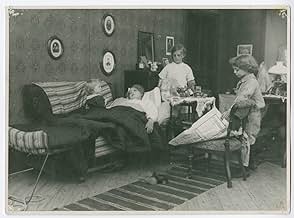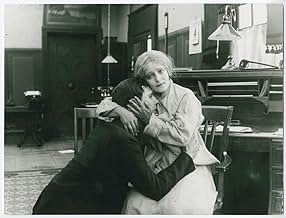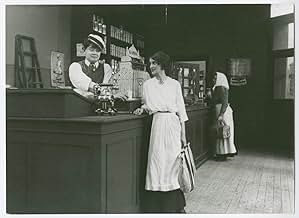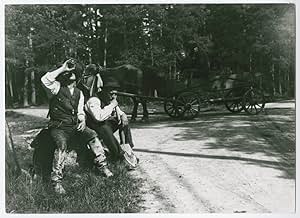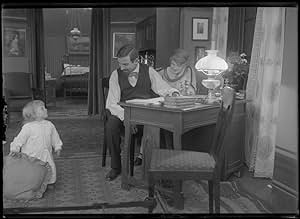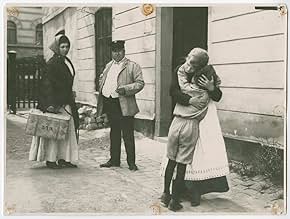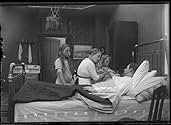ÉVALUATION IMDb
7,0/10
1,5 k
MA NOTE
Ajouter une intrigue dans votre langueFinancial struggles separate a single mother from her children.Financial struggles separate a single mother from her children.Financial struggles separate a single mother from her children.
- Director
- Writers
- Stars
Avis en vedette
Again, this is an early not-that-bad drama from Sjostrom about a person driven mad by tragic circumstances. It has a nice sense of restraint, especially for its era, with a fine performance by Hilda Borgstrom and a well-paced story. Nothing about the movie sucks. It just takes a little something extra for me to get involved with a silent film... some sort of avant-garde twist or dazzling technique or some thrilling action. Yeah, it's a good plot with a sympathetic protagonist, but my heart just wasn't in it. I can't imagine anyone besides a Sjostrom scholar watching this more than once.
6/10
6/10
The classic narrative films so familiar in "The Golden Age of Hollywood" movies had its beginning in October 1913 with Sweden's "Ingeborg Holm." Writer/director Victor Sjostrom adapted the Nils Krok 1906 play about a family who sinks to the depths of poverty after the father dies just as he assumes ownership of a store.
What sets "Ingeborg Holm" apart from the movies produced previously to the autumn of 1913 was the breath of its plot. Instead of taking a slice of a full-scale biography of the characters and producing a film on one particular stand alone event, here Sjostrom portrays an entire family's history, beginning when the head of the household receives bank funding to begin his enterprise. He continues the plot until years later, concluding in an emotional reunion with the mother and her long-absent son.
"Ingeborg Holm" fits all the criteria in cinema's full narrative definitions. A classic narrative begins by introducing all the characters who will propel the plot forward, just as Sjostrom illustrated with the comfortable middle-class family embarking on its new enterprise. Narratives contain a triggering event which shakes things up. Here, the father dies and his assistant at the store rips off the family's profits. Sjostrom continues the narrative plot by showing the mother-led family sinking into poverty, with the kids shunt off to the poor house. Events lead up to the conclusion, where the director visually reveals Sweden's lack of a safety net for the country's poor caused by, through no fault of themselves, their hardships.
Hollywood would follow Sjostrom's pattern of full narrative movies, especially during its classic 1930's--1950's golden age. There are variations of the narrative pattern in movies today, but the Swedes were the first to put into practice on film what literature and drama had been delivering for centuries.
Today's movie viewers may be familiar with Sjostrom by his last appearance on the screen in Ingmar Bergman's 1957's "Wild Strawberries," where he had the leading role of an aging professor who rediscovers his past through a journey to receive a honorarium.
What sets "Ingeborg Holm" apart from the movies produced previously to the autumn of 1913 was the breath of its plot. Instead of taking a slice of a full-scale biography of the characters and producing a film on one particular stand alone event, here Sjostrom portrays an entire family's history, beginning when the head of the household receives bank funding to begin his enterprise. He continues the plot until years later, concluding in an emotional reunion with the mother and her long-absent son.
"Ingeborg Holm" fits all the criteria in cinema's full narrative definitions. A classic narrative begins by introducing all the characters who will propel the plot forward, just as Sjostrom illustrated with the comfortable middle-class family embarking on its new enterprise. Narratives contain a triggering event which shakes things up. Here, the father dies and his assistant at the store rips off the family's profits. Sjostrom continues the narrative plot by showing the mother-led family sinking into poverty, with the kids shunt off to the poor house. Events lead up to the conclusion, where the director visually reveals Sweden's lack of a safety net for the country's poor caused by, through no fault of themselves, their hardships.
Hollywood would follow Sjostrom's pattern of full narrative movies, especially during its classic 1930's--1950's golden age. There are variations of the narrative pattern in movies today, but the Swedes were the first to put into practice on film what literature and drama had been delivering for centuries.
Today's movie viewers may be familiar with Sjostrom by his last appearance on the screen in Ingmar Bergman's 1957's "Wild Strawberries," where he had the leading role of an aging professor who rediscovers his past through a journey to receive a honorarium.
Victor Sjöström's early feature film "Ingeborg Holm" is not only considered by many the first film in the golden age of Swedish cinema lasting from 1913 to 1924 but also the real beginning of Swedish cinema in general. A film scholar, Peter Cowie, for one, claims that the film marks the highest achievement of the seventh art before David Wark Griffith's "The Birth of a Nation" (1915) which was to follow two years after. Although "Ingeborg Holm" is not as well known as many of its contemporary films, it surely stands out from the crowd to anyone who has seen more than a few films from the period. "Nothing like this was being made in 1913," writes Peter von Bagh, a Finnish film historian, capturing the historical importance of the film. The film's authenticity, realism, and moral seriousness have even been seen to bear far-reaching connections to Italian neorealism.
As many of the films of the Swedish golden age, "Ingeborg Holm" is also based on a literary source. It is based on a play by Nils Krok. The story concerns a married woman, Ingeborg Holm whose husband dies just after earning credit for establishing his own business. After the death of her husband, Ingeborg falls to the bottom of the society, loses her children to foster parents, and eventually ends up in an asylum.
The film is very raw and poignant in showing the grim consequences of social actions. It never, however, turns its back on the individual. Although it can be seen as a story of one woman's abasement, it grows into an intimate treatise on the sickness of a society that lacks humanity and tenderness. The shot of Ingeborg losing her children as a bureaucratic official calmly signs the documents in the background is definitive to say the least. The social reality as well as the psychological turmoil and suffering ignored by the society are relayed in a stark and riveting fashion. The scene bears a visual parallel to an earlier scene in which Ingeborg's husband dies in the foreground, while their children are innocently playing in the background of the image -- in another space, almost as if in another time, too.
Already the first film of the movement gives us its basic lessons: acting is more realistic than theatrical (to as large an extent as one can imagine given the film was made in 1913), moral themes are presented with the utmost seriousness, and emphasis lies on the simplicity and careful precision of mise-en-scène. Above all, the power of light is vital which was to be consummated in Sjöström's subsequent films such as "Terje Vigen" (1917) and "Körkarlen" (1921). In the beginning of the film, Ingeborg tries to continue her late husband's business, but fails, and we see the darkness in the grocery store almost swallowing her whole from the scarce source of light in the space.
Overall, and quite surprisingly, "Ingeborg Holm" lacks a sentimental or overly melodramatic tone. Sjöström's tone is subtle and restraint which once again reminds one of Italian neorealism. Although the film has no drama of nature which one so closely associates with the golden age of Swedish cinema, it uses a lot of outdoor on-location shooting, and its grimness, sobriety, and artistic excellence bring the style of the movement to mind very vividly. All in all, the film stands as a perfect instance for Peter Cowie's seemingly exaggerated claim that "there is no more stirring feat in the entire history of silent film than the Swedish achievements between 1913 and 1921." Sjöström's "Ingeborg Holm" is precisely this to any film enthusiast: something utterly stirring.
As many of the films of the Swedish golden age, "Ingeborg Holm" is also based on a literary source. It is based on a play by Nils Krok. The story concerns a married woman, Ingeborg Holm whose husband dies just after earning credit for establishing his own business. After the death of her husband, Ingeborg falls to the bottom of the society, loses her children to foster parents, and eventually ends up in an asylum.
The film is very raw and poignant in showing the grim consequences of social actions. It never, however, turns its back on the individual. Although it can be seen as a story of one woman's abasement, it grows into an intimate treatise on the sickness of a society that lacks humanity and tenderness. The shot of Ingeborg losing her children as a bureaucratic official calmly signs the documents in the background is definitive to say the least. The social reality as well as the psychological turmoil and suffering ignored by the society are relayed in a stark and riveting fashion. The scene bears a visual parallel to an earlier scene in which Ingeborg's husband dies in the foreground, while their children are innocently playing in the background of the image -- in another space, almost as if in another time, too.
Already the first film of the movement gives us its basic lessons: acting is more realistic than theatrical (to as large an extent as one can imagine given the film was made in 1913), moral themes are presented with the utmost seriousness, and emphasis lies on the simplicity and careful precision of mise-en-scène. Above all, the power of light is vital which was to be consummated in Sjöström's subsequent films such as "Terje Vigen" (1917) and "Körkarlen" (1921). In the beginning of the film, Ingeborg tries to continue her late husband's business, but fails, and we see the darkness in the grocery store almost swallowing her whole from the scarce source of light in the space.
Overall, and quite surprisingly, "Ingeborg Holm" lacks a sentimental or overly melodramatic tone. Sjöström's tone is subtle and restraint which once again reminds one of Italian neorealism. Although the film has no drama of nature which one so closely associates with the golden age of Swedish cinema, it uses a lot of outdoor on-location shooting, and its grimness, sobriety, and artistic excellence bring the style of the movement to mind very vividly. All in all, the film stands as a perfect instance for Peter Cowie's seemingly exaggerated claim that "there is no more stirring feat in the entire history of silent film than the Swedish achievements between 1913 and 1921." Sjöström's "Ingeborg Holm" is precisely this to any film enthusiast: something utterly stirring.
A woman loses her husband and children in quick succession as the hand of fate lands her a tragic blow. Good direction, cinematography and acting for the time make this one of the essential silents and a standout in Scandinavian and world cinema. A must for fans of film history and movies in general.
Ingeborg Holm / Margaret Day (1913) :
Brief Review -
Master Victor Sjöström's Swedish Melodrama is one of the earliest notable works about a mother's Tragedy in the cinema world. I am a big fan of Victor Sjöström and his prominent classics from the 1920s decade. It gives me an immense pleasure to view his early films, which were made on basic formulas as per the requirements and understanding of the era. Ingeborg Holm forced me to think about all the films based on Mother's tale, and I quickly realised how influential it was. It was much before Chinese cinema made "SheNu" / "The Goddess" (1934) and Indian cinema made the classic "Aurat" (1940). However, Holm's story is not that broad. It sticks to the basics while dealing with a relatable and emotional topic like motherhood. When I tried to find out the similarities between this film and other ones, I found the Marathi film "Chimni Pakhare" close to it, but then the main character had to go through different conflicts. The best close answer was the Telugu flick, "Jeevana Jyothi" (1975), which also had a double role boost. Imagine, a film from the 1910s decade influencing modern well-known films. The film is about a mother with three children who had to send her children to foster homes due to the financial crisis after her husband's death. The insanity angle is also used well by mixing it with high-end melodrama. I remember Hilda Borgström from Victor's "The Phantom Carriage" (1921), but today I noticed that her face and expressions are familiar with those of Lillian Gish. Her face kept reminding me of Gish, who also happened to work during the same period of time. Victor Sjöström's film has everything to make a classy watch, but it missed the classic tag by just an inch, in my opinion. Nevertheless, a great work from the early stages of movies that set many iconic formulas once and for all.
RATING - 7.5/10*
By - #samthebestest.
Master Victor Sjöström's Swedish Melodrama is one of the earliest notable works about a mother's Tragedy in the cinema world. I am a big fan of Victor Sjöström and his prominent classics from the 1920s decade. It gives me an immense pleasure to view his early films, which were made on basic formulas as per the requirements and understanding of the era. Ingeborg Holm forced me to think about all the films based on Mother's tale, and I quickly realised how influential it was. It was much before Chinese cinema made "SheNu" / "The Goddess" (1934) and Indian cinema made the classic "Aurat" (1940). However, Holm's story is not that broad. It sticks to the basics while dealing with a relatable and emotional topic like motherhood. When I tried to find out the similarities between this film and other ones, I found the Marathi film "Chimni Pakhare" close to it, but then the main character had to go through different conflicts. The best close answer was the Telugu flick, "Jeevana Jyothi" (1975), which also had a double role boost. Imagine, a film from the 1910s decade influencing modern well-known films. The film is about a mother with three children who had to send her children to foster homes due to the financial crisis after her husband's death. The insanity angle is also used well by mixing it with high-end melodrama. I remember Hilda Borgström from Victor's "The Phantom Carriage" (1921), but today I noticed that her face and expressions are familiar with those of Lillian Gish. Her face kept reminding me of Gish, who also happened to work during the same period of time. Victor Sjöström's film has everything to make a classy watch, but it missed the classic tag by just an inch, in my opinion. Nevertheless, a great work from the early stages of movies that set many iconic formulas once and for all.
RATING - 7.5/10*
By - #samthebestest.
Le saviez-vous
- AnecdotesNoted as the first true narrative film, its remarkable narrative continuity would characterize the style now known as classical Hollywood, which dominated the global film industry for the majority of the century.
- ConnexionsFeatured in Victor Sjöström - ett porträtt av Gösta Werner (1981)
Meilleurs choix
Connectez-vous pour évaluer et surveiller les recommandations personnalisées
Détails
- Durée
- 1h 36m(96 min)
- Mixage
- Rapport de forme
- 1.33 : 1
Contribuer à cette page
Suggérer une modification ou ajouter du contenu manquant

